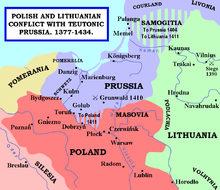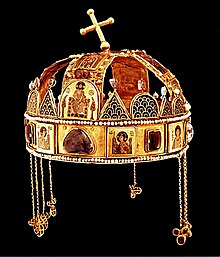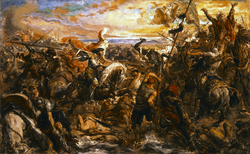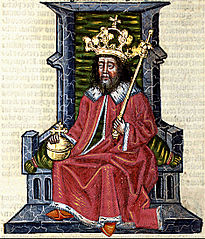Władysław III of Poland
| Władysław III | |
|---|---|
Roman Catholic |
Władysław III of Poland
Władysław's succeeded his father shortly before turning ten in 1434 and was, therefore, deemed unfit to rule until coming of age. Cardinal Zbigniew Oleśnicki acted as regent and a temporary provisores council executed power in the king's name. However, Władysław's legitimacy to the crown was contested by Lesser Polish nobles favouring the candidacy of Siemowit V of Masovia, who was of Piast lineage. In the aftermath of the coronation, Spytko III of Melsztyn accused Oleśnicki, the council and the Catholic Church of exploiting the king's youth to hold authority. A sympathiser with the Czech Hussites, Spytko was killed at the Battle of Grotniki in 1439, thus ending the hostilities.
Władysław simultaneously faced the effects of the
The policy of the Kingdom of Poland under Władysław and Oleśnicki was to reclaim lost territories such as
With the Turkish grip over the Balkans weakened in the aftermath of the Hungarian–Ottoman War (1437–1442), the papacy and papal legate Julian Cesarini urged Władysław to launch the Crusade of Varna. After initial successes, the outnumbered Christian forces engaged in a decisive battle at Varna, where Władysław was killed in a heroic cavalry charge against Sultan Murad II. His body was never recovered and its disappearance led to numerous survival theories or legends, none of which have been confirmed. Władysław's legacy in Poland and Hungary is divisive, yet Władysław remains a notable figure in countries like Bulgaria which were under Ottoman domination. He was succeeded in Poland by his younger brother Casimir IV, and in Hungary-Croatia by his rival Ladislaus V the Posthumous.
Early life, 1424–1434
Childhood, 1424–1431

Władysław was born in
In 1427, the
Opposition and Cardinal Oleśnicki, 1432–1434

From a young age, Władysław was surrounded by advisors loyal to
There was growing antagonism in the demesne and the challengers feared that crowning a young and inexperienced king would invest Oleśnicki with too much power over the affairs of state.[11] Others repudiated a son of formerly-pagan Jogaila on the Polish throne and yearned for a living descendant of the Piast dynasty. The candidacy of Siemowit V remained a considerable threat to Władysław, especially that Siemowit was of royal Piast lineage and a member of a branch which ruled the Duchy of Masovia since the Testament of Bolesław III Wrymouth in the 12th century.[12]
Many opponents also attempted to counter the power of the
Reign, 1434–1444
Coronation, 1434

Władysław was crowned at Wawel Cathedral on 25 July 1434 by the elderly Wojciech Jastrzębiec.
Chronicler
Regency, 1434–1438
Shortly after the coronation, senior nobles held both covert and open conventions to discuss the possibility of instituting a
It is believed that Władysław did not have a decisive voice in politics and the situation did not change even after the Sejm (Polish parliament) had gathered in Piotrków in 1438, and declared the fourteen-year-old king to have attained his majority.[24]
Civil war in Lithuania, 1434–1438

Władysław faced certain challenges early in his reign, in particular the inherited situation in the Grand Duchy of Lithuania was precarious and the
A Polish retinue of approximately 4,000 men under Jakub Kobylański assisted the Lithuanians headed by Sigismund Kęstutaitis and Michael Žygimantaitis; their joint army defeated Švitrigaila and his allies, Sigismund Korybut and the Livonian Order, on 1 September 1435 at the Battle of Wiłkomierz.[28] Švitrigaila fled eastward, but eventually lost the support of the Ruthenians residing in the Grand Duchy and went into exile to Moldavia in 1438, thus ending civil war.[26] However, unrest re-emerged when Sigismund Kęstutaitis was assassinated on 20 March 1440 and Władysław's younger brother, Casimir, was proclaimed Grand Duke by Jonas Goštautas and the Lithuanian Council of Lords on 29 June 1440.[29][30] This was met with hostility at the Polish court, especially that Casimir was underage and that the Poles hoped for a vicegerent that would submit to Poland.[30] Regardless of the outcome, Władysław continued to use the title of Supreme Duke of Lithuania until death under the conditions of the 1413 Union of Horodło.[31][32]
The battle also proved momentous in combating the Livonian Order as its
Domestic and foreign policy, 1438–1440

The successive years were marked by the extirpation of Polish Hussites under the
The court also devised the return of territories once lost, most notably the southern
The union with Lithuania remained impregnable and a dynastic union with the Kingdom of Hungary was to be formed as Sigismund had no male heirs.[43] The Polish Sejm and statesmen[e] hoped that, by marrying Władysław to one of Sigismund's grand-daughters, Poland could secure his accession in Hungary and foist Jagiellonian rule there.[43] This would restore a union of Hungary and Poland not seen since the reign of Louis I of Anjou (1370–1382).[43] The union would allow Poland to re-negotiate disputed territories between the Poles and the Hungarians, including Halych (later constituting Galicia) and Moldavia.[43] In response, Poland would propose a military alliance and vow the expulsion of the Ottoman Turks from Hungarian lands.[43]
King of Hungary and Croatia, 1440

In October 1439, Albert II died leaving the Austrian, Bohemian and Hungarian thrones unoccupied.[44] His only son, born in February 1440, became known as Ladislaus the Posthumous.[44] Ladislaus' claim to the Duchy of Austria was acknowledged in accordance with Albert's testament.[45][46] Under the influence and pressure of Oldřich II of Rosenberg, the Catholic nobles were also inclined to endorse Ladislaus' hereditary right to Bohemia.[47][46] Conversely, the Hungarians were not willing to pass his candidacy and began dialogue with the Poles.[46] In early January 1440, the Hungarian Estates rejected the deceased king's testament at an assembly in Buda that would place the regency in the hands of Frederick III Habsburg.[44]
Due to the general animosity towards the
Elizabeth did not approve of the Estates' election and on 15 May 1440 she had her son crowned with the
Discord and unrest, 1440–1442

Shortly after Władysław's accession the conflict with the supporters of Elizabeth deepened.[52] The western and northern parts of the country remained on the side of the queen and opposing magnates, chiefly the Counts of Celje (Cilli), the Garai family and Dénes Szécsi, Archbishop of Esztergom.[52] In turn, the eastern regions and Transylvania upheld Władysław and his partisans, among them John Hunyadi who became a leading political and military figure in Hungary.[53]
In order to assert her claim, Elizabeth had to maintain the wealthy mining counties in what now constitutes
The western territories as well as some 70 fortresses under Ulrich II, Count of Celje in modern-day Austria, Croatia and Slovenia remained stalwart and loyal to the queen.[54] Before the end of 1440, Hunyadi attacked Győr but was unable to take the garrisoned city.[55] He was, however, successful in capturing local townships and villages around Buda and Székesfehérvár to prevent the escape of nobles and designated traitors.[55] This proved paramount when Ulrich II made an attempt to flee to Bratislava (Pozsony); he was caught by a Polish detachment and subsequently imprisoned at Władysław's behest.[55] Concurrently, Ladislaus Garai instigated a rebellion in the south.[56] Hunyadi, together with Nicholas of Ilok, annihilated Garai's army at Bátaszék on 10 September 1440.[56] In January 1441, Ulrich was released from captivity, pledged an oath of loyalty to Władysław and freed the hostages held by his troops.[56]
Elizabeth prolonged her resistance until December 1442, when a peace treaty was signed at Győr under the auspices of Cardinal Julian Cesarini.[57] Elizabeth died not long after meeting Władysław and exchanging gifts; her supporters claimed that she was poisoned on his orders to prevent their marriage.[58] Cesarini had the treaty ratified by Frederick under the pressure of Pope Eugene, though Frederick abstained from doing so until May 1444.[58] Due to the internal unrest, Hungary became vulnerable militarily and was severely weakened for the Turkish campaign.[57]
Crusade against the Muslim Ottomans, 1443–1444

The prelude to the crusade began when the Turks were defeated in the
Throughout the autumn of 1442, Cesarini and the

On 15 April 1444, at the
In August, a Polish assembly at
In mid-August 1444, the
Death at Varna and succession, 1444

The Venetian treachery placed the large Ottoman army of around 60,000 men in proximity to the unsuspecting 16,000 crusaders, almost outnumbering the Christians by three to one.
Hunyadi is purported to have proposed that the Christian left assists the right flank to move the Turks out of position, and stated that "the son of Osman's army shall be defeated".[77] The Ottoman troops under Hadım Şehabeddin of Rumelia began to break and some fled the battle, though the Turkish resistance was fierce.[77] One of the crusaders, Andreas de Pallatio, later wrote in his memoirs that Władysław seized the initiative on the Christian right flank and tore into Şehabeddin's ranks like "a new Caesar", pushing the Rumelians up the valley's slope.[77] Many of the novice yet still elite Janissaries and azebs were driven back.[78] Pallatio also notes that the size of Murad's army was too great to counter and it seemed as if the Christian offensive barely inflicted any major casualties.[79] Władysław's men quickly became exhausted, with many wounded by arrows and battered, including Hunyadi.[79] In spite of this, the majority of the Ottoman army either fled or was dead.[80] Consequently, Murad decided to seek refuge in his fortified encampment in the rear.[80]
Facing desperate circumstances and seeing Hunyadi's struggle against the Rumelian
Władysław was succeeded in Poland by his younger brother, Duke Casimir IV of Lithuania, in 1447, after a three-year interregnum.[86] In Hungary, he was succeeded by his former rival, the child-king Ladislaus the Posthumous.[86]
Appearance and personal life
According to 19th-century sources based on medieval chronicles, Władysław was of medium height, with a
Władysław had no children and did not marry. Contemporary sources suggest that he was
Legacy

Władysław's legacy as King of Hungary was tarnished in existing records by the
Following his death, Władysław III was commemorated in many songs and poems.[92]
A main boulevard and residential district in Varna are named after Władysław. In 1935 a park-museum, Władysław Warneńczyk, opened in Varna, with a symbolic cenotaph built atop of an ancient Thracian mound tomb. There had been also a football team named after Vladislav in Varna, present day its inheritor is known as PFC Cherno More Varna.
Legend of survival

According to a
According to the tradition, he felt his defeat at Varna was a warning sign from God (since he declared war on a false pretext, violating the truce with the Ottoman Muslims). Thus, he wandered as a pilgrim, seeking forgiveness, which he found in Jerusalem. For the rest of his life he would deny his identity. A delegation of Polish monks went to Madeira to question him and certified he was in fact the long lost king, now living in secrecy. He declined their suggestion to ascend the Polish throne again.
According to another controversial version of the legend, promoted by Manuel da Silva Rosa, Władysław (as Henrique Alemão) was the biological father of Christopher Columbus.
Gallery
- Gallery
-
The Royal Seal of Władysław III, 1438.
-
Coat of arms featuring the symbols of Poland, Lithuania and Hungary.
-
The Memorial of the Battle in Varna, built on an ancient Thracian mound tomb, bearing the name of the fallen king.
-
A more accurate portrayal in theChronica Polonorum, 1519.
-
Imaginary portrait from Thuróczi János' Chronica Hungarorum (Władysław was only 20 when he died).
-
Drawing by Jan Matejko, a 19th-century imaginary depiction based on historical accounts.
-
Church, Madalena do Mar, Madeira, hypothetical burial place of Władysław III.
See also
- History of Poland (1385–1569)
- List of Polish monarchs
Notes
- ^ Also known in English as Vladislaus, Wladislaus, Wladislas, Ladislaus or Ladislas.
Hungarian: I. Ulászló;
Slovak: Vladislav I;
Czech: Vladislav Varnenčík;
Bulgarian: Владислав Варненчик (Vladislav Varnenchik);
Lithuanian: Vladislovas III Varnietis;
Croatian: Vladislav I. Jagelović. - ^ He inherited the title of the Supreme Duke (Supremus Dux) of Grand Duchy of Lithuania as the eldest son of Władysław II Jagiełło, who adopted this title after the Union of Horodło in 1413.
- ^ Teresa Pac incorrectly provides the date as 25 August 1434 in her work Common Culture and the Ideology of Difference in Medieval and Contemporary Poland.[17]
- ^ The Polish term "rozum", embedded in the chronicles of Jan Długosz, is directly translated as "the mind" and can be interpreted as "wisdom".[22]
- ^ Oleśnicki often spoke in the name of political leaders in the country.
Bibliography
Citations
- ^ Murray 2006, p. 686.
- ^ a b c Spórna, Wierzbicki & Wygonik 2004, p. 468.
- ^ a b Korytkowski 1883, p. 131.
- ^ ZPE.
- ^ Michalik, Małecki & Kurz 1996, p. 59.
- ^ Duczmal 1996, pp. 277, 427.
- ^ a b Duczmal 1996, p. 277.
- ^ Jefferson 2012, p. 148.
- ^ Kwiatkowski 1883, p. 1.
- ^ a b c d Kwiatkowski 1883, p. 2.
- ^ Kwiatkowski 1883, pp. 2–3.
- ^ Spórna, Wierzbicki & Wygonik 2004, p. 401.
- ^ a b Sokołowski & Inlender 1897, p. 312.
- ^ a b c Sokołowski & Inlender 1897, p. 311.
- ^ Sokołowski & Inlender 1897, pp. 311–312.
- ^ Reddaway et al. 1950, p. 234.
- ^ a b c d Pac 2022, p. 150.
- ^ a b Pac 2022, pp. 149–150.
- ^ a b Długosz 1869, p. 506.
- ^ a b Długosz 1869, pp. 506–507.
- ^ a b Nowakowska 2017.
- ^ a b c Długosz 1869, p. 507.
- ^ Olejnik 1996, p. 55.
- ^ Prokop 2001, p. 23.
- ^ a b c Kiaupienė 2008, pp. 205–211.
- ^ a b Sužiedėlis 1970–1978, pp. 348–350.
- ^ Gieysztor 1998, pp. 734–735.
- ^ Mačiukas 2015.
- ^ Sužiedėlis 2011, p. 71.
- ^ a b Scott 2015, p. 393.
- ^ Mikulec & Polívka 2007, p. 248.
- ^ Kiaupa 2000, pp. 154–155.
- ^ Urban 2003, pp. 311–313.
- ^ a b Błachowska 2009, p. 325.
- ^ Jasienica 1978, p. 142.
- ^ Reddaway et al. 1950, p. 235.
- ^ Frost 2018, p. 140.
- ^ a b Reddaway et al. 1950, pp. 235–236.
- ^ a b Bunar & Sroka 1996, p. 90.
- ^ a b c Jasienica 1965, p. 155.
- ^ a b Związek Literatów Polskich 1961, p. 70.
- ^ Długosz 1869, p. 563.
- ^ a b c d e f g h i Reddaway et al. 1950, p. 236.
- ^ a b c d e Ágoston 2023, p. 64.
- ^ Beller 2006, p. 34.
- ^ a b c d Pálosfalvi 2002, p. 143.
- ^ Šmahel 2011, p. 164.
- ^ a b Solymosi & Körmendi 1981, p. 257.
- ^ Davis 2024, p. 15.
- ^ Ágoston 2023, pp. 64–65.
- ^ Stone 2014, p. 22.
- ^ a b Museranu 2018, p. 71.
- ^ Museranu 2018, pp. 71–72.
- ^ a b c d e f Museranu 2018, p. 72.
- ^ a b c Museranu 2018, p. 73.
- ^ a b c Museranu 2018, pp. 73–74.
- ^ a b Reddaway et al. 1950, p. 239.
- ^ a b Setton 1969, p. 287.
- ^ a b c d Setton 1969, pp. 287–288.
- ^ Jefferson 2012, p. 285.
- ^ Giurescu & Matei 1976, p. 88.
- ^ a b c Setton 1969, p. 288.
- ^ a b Malone-Lee 2023.
- ^ Piechocki 2021, pp. 95–96.
- ^ a b Cazacu 2017, p. 43.
- ^ Treptow 2022.
- ^ Setton 1976, p. 82.
- ^ a b Setton 1976, pp. 82–83.
- ^ a b c d Setton 1976, p. 86.
- ^ a b c d e Setton 1976, p. 87.
- ^ Setton 1976, p. 83.
- ^ a b Setton 1976, p. 88.
- ^ a b c d Setton 1976, p. 89.
- ^ Setton 1976, pp. 89–90.
- ^ a b c d e Setton 1976, p. 90.
- ^ Jefferson 2012, pp. 463–464.
- ^ a b c Jefferson 2012, p. 464.
- ^ Jefferson 2012, pp. 465–466.
- ^ a b Jefferson 2012, p. 465.
- ^ a b c Jefferson 2012, p. 466.
- ^ Jefferson 2012, p. 467.
- ^ a b Pope Pius II 2013, pp. 87–88.
- ^ Setton 1969, p. 310.
- ^ a b Shirogorov 2021, p. 40.
- ^ Besala 2003, p. 98.
- ^ a b Topolski 1986, p. 58.
- ^ a b c Kiliński 1872, p. 92.
- ^ Muzeum Historii Polski.
- ^ Wolnicka 2017.
- ^ a b Lewandowski 2014, p. 59.
- ^ Długosz 1869.
- ^ Michałowska 1995, pp. 697–706.
- ^ a b c São Joaquim e Santa Ana, Museu de Arte Sacra do Funchal.
- ^ Rei de Portugal, D. Afonso V, foi o seu padrinho de casamento – A Lenda... Henrique Alemão ou Ladislau III
- ^ Henrique Alemão- Ladislau III da Polónia Lenda ou História?
- ^ Diocese do Funchal Archived 2 October 2011 at the Wayback Machine, Igreja Santa Maria Madalena em Madalena do Mar.
Sources
- Ágoston, Gábor (2023). The Last Muslim Conquest. The Ottoman Empire and Its Wars in Europe. Princeton: University Press. ISBN 9780691205397.
- Beller, Steven (2006). A Concise History of Austria. Cambridge University Press. ISBN 9780521478861.
- Besala, Jerzy (2003). Tajemnice historii Polski. Poznań: Wydawn. Podsiedlik-Raniowski i Spółka. ISBN 9788373414341.
- Błachowska, Katarzyna (2009). Wiele historii jednego państwa: obraz dziejów Wielkiego Księstwa Litewskiego do 1569 roku w ujęciu historyków polskich, rosyjskich, ukraińskich, litewskich i białoruskich w XIX (in Polish). Warszawa (Warsaw): Neriton. ISBN 9788375430769.
- Bunar, Piotr; Sroka, Stanisław (1996). Wojny, bitwy i potyczki w średniowiecznej Polsce (in Polish). Kraków: Universitas. ISBN 9788370524449.
- Cazacu, Matei (2017). Dracula. Leiden: Brill. ISBN 9789004349216.
- Davis, G. Doug (2024). Croatian Cultural Renaissance. From the Margins to the Crossroad of Europe. Lanham: Lexington Books. ISBN 9781666958706.
- OCLC 919560600.
- Duczmal, Małgorzata (1996). Jagiellonowie. Leksykon biograficzny (in Polish). Kraków: Wydawnictwo Literackie. ISBN 9788308025772.
- ISBN 9780192568144.
- ISBN 0-521-38296-3.
- Giurescu, Constantin C.; Matei, Horia C. (1976). Histoire Chronologique de la Roumanie (in French). Editura științifică și enciclopedică.
- OCLC 837234270.
- Jefferson, John (2012). The Holy Wars of King Wladislas and Sultan Murad. The Ottoman-Christian Conflict from 1438-1444. Leiden: Brill. ISBN 9789004229259.
- Kiaupa, Zigmantas (2000). The History of Lithuania Before 1795 (English ed.). Vilnius: Lithuanian Institute of History. pp. 154–155. ISBN 9986810132.
- Kiaupienė, Jūratė (2002). "Gediminaičiai ir Jogailaičiai prie Vytauto palikimo". Gimtoji istorija. Nuo 7 iki 12 klasės (in Lithuanian). Vilnius: Elektroninės leidybos namai. ISBN 9986921694.
- Kiliński, Teodor (1872). Dzieje narodu polskiego z tablicą chronologiczną aż do naszych czasów dla użytku młodżiezy z dodatkiem jeografii i mapy dawnéj Polski (in Polish). Poznań: Kamieński i Spółka. OCLC 1412087021.
- Korytkowski, Jan (1883). Prałaci i kanonicy Katedry Metropolitalnej Gnieźnieńskiej (in Polish). Gniezno: Langi. OCLC 1355986126.
- Kwiatkowski, Saturnin (1883). Ostatnie lata Władysława Warneńczyka (in Polish). Lwów: Gubrynowicz i Schmidt. OCLC 749409692.
- Lewandowski, Piotr (2014). Grzech sodomii w przestrzeni politycznej, prawnej i społecznej Polski nowożytnej (in Polish). Będzin: e-bookowo.pl. ISBN 9788378594239.
- Mačiukas, Žydrūnas (2015). "LDK vidaus karo atomazga: Pabaisko mūšio 580-osioms metinėms paminėti" (in Lithuanian). Lietuvos žinios. Archived from the original on 23 September 2016. Retrieved 3 June 2016.
- Michalik, Marian B.; Małecki, Jan M.; Kurz, Andrzej (1996). Kronika Krakowa (in Polish). Kraków: Wydawn. Kronika. ISBN 9788386079070.
- Michałowska, Teresa (1995). Średniowiecze (in Polish) (First ed.). Warszawa (Warsaw): Wydawnictwo Naukowe PWN. pp. 697–706. ISBN 8301114525.
- Mikulec, Jiří; Polívka, Miloslav (2007). Per saecula ad tempora nostra (in Czech and Polish). Vol. 1. Praha (Prague): Historický ústav Akademie věd České republiky. ISBN 9788072861163.
- Murray, Alan V. (2006). The Crusades [4 Volumes]. Santa Barbara: ABC-CLIO. ISBN 9781576078631.
- Museranu, Camil (2018). John Hunyadi. Defender of Christendom. Las Vegas: Histria Books. ISBN 9781592111152.
- Muzeum Historii Polski. "Władysław III Warneńczyk". muzhp.pl. Retrieved 27 March 2024.
- Nowakowska, Natalia (2017). Church, State and Dynasty in Renaissance Poland. Taylor & Francis, Routledge. ISBN 9781351951555.
- Pálosfalvi, Tamás (2002). "V. László". In Kristó, Gyula (ed.). Magyarország vegyes házi királyai [The Kings of Various Dynasties of Hungary] (in Hungarian). Szukits Könyvkiadó. pp. 139–150. ISBN 963-9441-58-9.
- Olejnik, Karol (1996). Władysław III Warneńczyk (in Polish). Szczecin: Wydawn. Archiwum Państwowego "Dokument". ISBN 9788386992102.
- Pac, Teresa (2022). Common Culture and the Ideology of Difference in Medieval and Contemporary Poland. Lanham, Maryland: Lexington Books. ISBN 9781793626929.
- Piechocki, Katharina N. (2021). Cartographic Humanism. The Making of Early Modern Europe. Chicago: University Press. ISBN 9780226816814.
- ISBN 9780813221823.
- Prokop, Krzysztof Rafał (2001). Polscy kardynałowie (in Polish). Kraków: WAM. ISBN 9788370978655.
- Reddaway, W. F.; Penson, J. H.; Halecki, Oskar; Dyboski, R. (1950). The Cambridge history of Poland from the origins to Sobieski - to 1696. Cambridge: University Press. OCLC 877250752.
- Scott, Hamish M. (2015). The Oxford Handbook of Early Modern European History, 1350-1750. Vol. 2. Oxford: University Press. ISBN 9780199597260.
- ISBN 9780299107444.
- ISBN 9780871691149.
- Shirogorov, Vladimir (2021). War on the Eve of Nations. Lexington Books. ISBN 9781793622419.
- Šmahel, František (2011). "The Hussite Revolution (1419–1471)". In Pánek, Jaroslav; Tůma, Oldřich (eds.). A History of the Czech Lands. Charles University in Prague. pp. 149–187. ISBN 978-80-246-1645-2.
- Sokołowski, August; Inlender, Adolf (1897). Dzieje Polski illustrowane (in Polish). Vol. 2. Vienna: Moritz Perles. OCLC 726801449.
- Solymosi, László; Körmendi, Adrienne (1981). "A középkori magyar állam virágzása és bukása, 1301–1526 [The Heyday and Fall of the Medieval Hungarian State, 1301–1526]". In Solymosi, László (ed.). Magyarország történeti kronológiája, I: a kezdetektől 1526-ig [Historical Chronology of Hungary, Volume I: From the Beginning to 1526] (in Hungarian). Akadémiai Kiadó. pp. 188–228. ISBN 963-05-2661-1.
- Spórna, Marcin; Wierzbicki, Piotr; Wygonik, Edyta (2004). Słownik władców Polski i pretendentów do tronu polskiego (in Polish). Kraków: Wydawn. Zielona Sowa. ISBN 9788372205605.
- Stone, Daniel Z. (2014). The Polish-Lithuanian State, 1386-1795. University of Washington Press. ISBN 9780295803623.
- Sužiedėlis, Saulius (2011). Historical Dictionary of Lithuania. Lanham: Scarecrow Press. ISBN 9780810875364.
- Sužiedėlis, Simas, ed. (1970–1978). "Švitrigaila". LCCN 74-114275.
- Urban, William (2003). Tannenberg and After. Chicago: Lithuanian Research and Studies Center. pp. 311–313. ISBN 0929700252.
- Topolski, Jerzy (1986). An outline history of Poland. Warsaw: Interpress. ISBN 9788322321188.
- Treptow, Kurt (2022). Vlad III Dracula. The Life and Times of the Historical Dracula. Las Vegas: Histria Books. ISBN 9781592112142.
- Wolnicka, Agnieszka (2017). "Czy Władysław Warneńczyk był gejem?". ciekawostkihistoryczne.pl. Ciekawostki Historyczne. Retrieved 27 March 2024.
- ZPE. "Władysław Warneńczyk: Nadzieja dynastii". zpe.gov.pl (in Polish). Ministerstwo Edukacji i Nauki. Retrieved 17 March 2024.
- Związek Literatów Polskich (1961). Twórczość (in Polish). Vol. 17. Warszawa (Warsaw): RSW "Prasa-Książa-Ruch". OCLC 1767892.
External links
- Bain, Robert Nisbet (1911). . Encyclopædia Britannica. Vol. 28 (11th ed.). pp. 765–767, see page 766, para 3.
Wladislaus III. (1424–1444), king of Poland and Hungary.....








